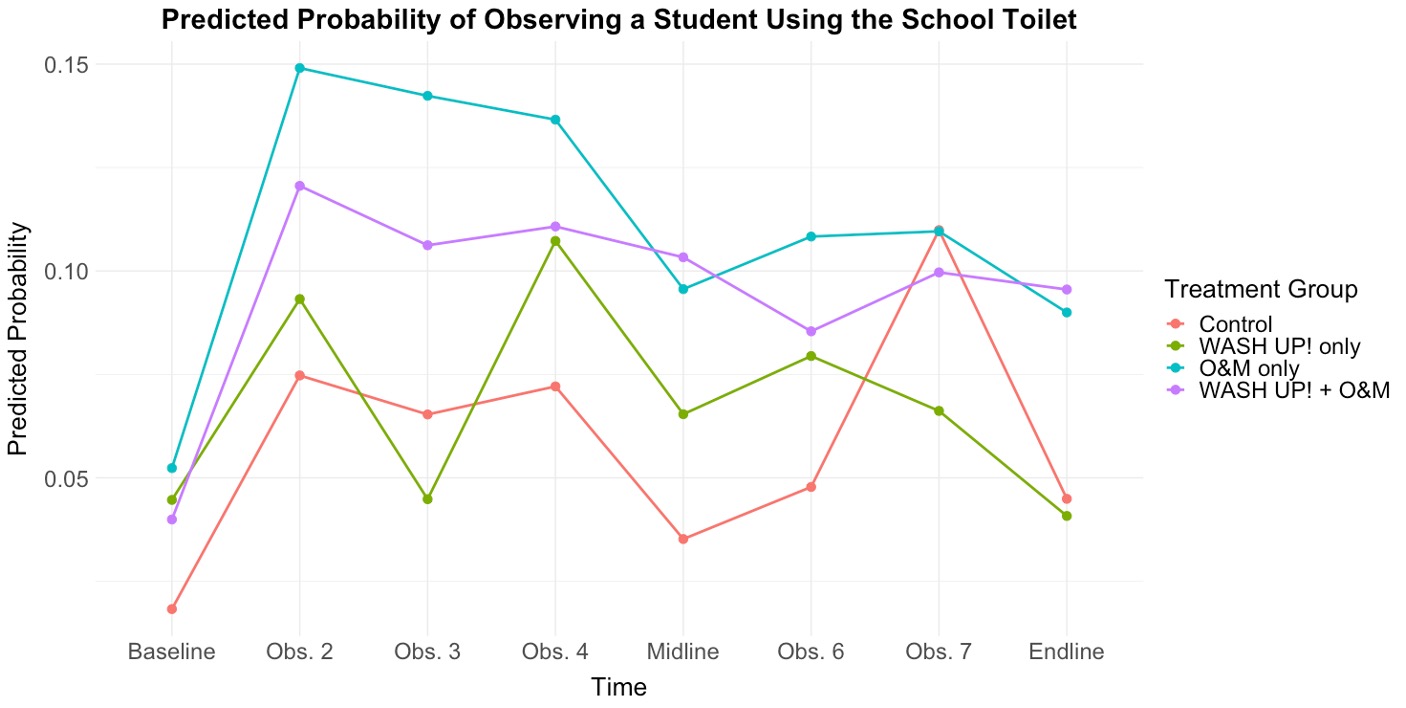Global Neonatal & Children's Health 1
Session: Global Neonatal & Children's Health 1
729 - Quantifying the Effects of Water, Sanitation, and Hygiene (WASH) Education and Infrastructure Operation and Maintenance on Students’ Toilet Use and Handwashing in Indian Primary Schools
Friday, April 25, 2025
5:30pm - 7:45pm HST
Publication Number: 729.6390
Gracie M. Hornsby, Stanford University, Palo Alto, CA, United States; Gary Darmstadt, Department of Pediatrics, Stanford University School of Medicine, Palo Alto, CA, United States; Jenna Davis, Stanford University, Stanford, CA, United States

Gracie M. Hornsby, MA (she/her/hers)
PhD Candidate
Stanford University
Palo Alto, California, United States
Presenting Author(s)
Background: Using improved sanitation facilities and handwashing with soap are important health behaviors that are linked to reduced incidence of diarrhea and respiratory infection in children. The school environment has often been utilized for delivering water, sanitation, and hygiene (WASH) behavior change programming to inculcate students with healthy WASH habits and expand access to WASH infrastructure. We hypothesize that the combination of education and post-construction operation and maintenance (O&M) of WASH infrastructure promotes student adoption of healthy WASH habits, leading to long-term health benefits from investments.
Objective: To test the individual and combined effects of WASH education and infrastructure O&M on students’ WASH knowledge and behavior.
Design/Methods: This 4-arm, cluster randomized controlled trial was conducted in 200 government primary schools in rural Uttar Pradesh, India. Treatment arms (curriculum only, O&M only, curriculum + O&M) included 50 schools each and were compared to a 50-school control arm. Data was collected via structured surveys of students and teachers at baseline, midline, and endline, with an average of 7,338 student surveys per round. We also conducted 9 unannounced infrastructure observations and 8 unannounced student behavior observations per school. A pre-analysis plan was registered with 3ie’s Registry for International Development Impact Evaluations.
Results: Student knowledge of critical handwashing times and germs increased significantly in arms receiving the WASH curriculum. The probability of a student reporting good germ knowledge increased by 0.38-0.45 (p < 0.001) above the control. Among schools receiving O&M support, toilets were more likely to be unlocked (0.15-0.21; p< 0.05), flush properly, have water for anal cleansing (0.21; p< 0.05), and be cleaner (p < 0.05). Observed student toilet use only increased significantly in the O&M arm, and the effect size was small (0.022; p< 0.05). No arms displayed significant increases in student handwashing.
Conclusion(s): The curriculum improved students’ WASH knowledge and the O&M intervention improved toilet-related infrastructure outcomes and student toilet use. However, there were not synergistic impacts on student toilet use from delivering education and O&M together. The O&M intervention did not change the enabling environment for handwashing and neither intervention was effective for improving student handwashing, suggesting that something more is required to improve student handwashing. Follow up analyses are underway to better understand the conditions under which handwashing and toilet use improved.
Predicted Probability of of a Student Reporting Accurate and Relevant Germ Knowledge
.jpg) Results of a generalized linear mixed model indicate that the probability of a student reporting good germ knowledge increased by an additional 0.38 (p < 0.001) above the trend in the control group among students in the curriculum only arm (green) and by an additional 0.45 (p < 0.001) above the control group among students in the curriculum plus O&M arm (purple). This model also included fixed effects for student gender and grade (Grade 1 or Grade 4) which revealed that boys and girls reaped similar benefits from the program. The probability of Grade 1 and Grade 4 students reporting good germ knowledge also increased at a similar rate, despite Grade 1 students starting with much worse germ knowledge.
Results of a generalized linear mixed model indicate that the probability of a student reporting good germ knowledge increased by an additional 0.38 (p < 0.001) above the trend in the control group among students in the curriculum only arm (green) and by an additional 0.45 (p < 0.001) above the control group among students in the curriculum plus O&M arm (purple). This model also included fixed effects for student gender and grade (Grade 1 or Grade 4) which revealed that boys and girls reaped similar benefits from the program. The probability of Grade 1 and Grade 4 students reporting good germ knowledge also increased at a similar rate, despite Grade 1 students starting with much worse germ knowledge. Toilet Cleanliness Score
.jpg) Toilet cleanliness observations were collected at 8 unannounced spot checks among toilets that were unlocked (observable). Toilets were scored on (1) the presence of urine or feces outside the toilet pan, (2) the presence of flies or other pests, (3) the presence of mud, dirt, or trash, and (4) the presence of offensive odor. Each indicator was scored on a scale of “A lot” (0), “Some” (1), or “None/Almost none” (2), meaning a higher score indicates a cleaner toilet. Results of a generalized additive model for location, scale and shape (gamlss) indicate that toilets in the O&M only arm (blue) and curriculum plus O&M (purple) became significantly cleaner (p < 0.001 and p=0.04, respectively) just after the intervention began (post-baseline) and sustained that improvement for the entire study period.
Toilet cleanliness observations were collected at 8 unannounced spot checks among toilets that were unlocked (observable). Toilets were scored on (1) the presence of urine or feces outside the toilet pan, (2) the presence of flies or other pests, (3) the presence of mud, dirt, or trash, and (4) the presence of offensive odor. Each indicator was scored on a scale of “A lot” (0), “Some” (1), or “None/Almost none” (2), meaning a higher score indicates a cleaner toilet. Results of a generalized additive model for location, scale and shape (gamlss) indicate that toilets in the O&M only arm (blue) and curriculum plus O&M (purple) became significantly cleaner (p < 0.001 and p=0.04, respectively) just after the intervention began (post-baseline) and sustained that improvement for the entire study period. Predicted Probability of Observing a Student Using the School Toilet
 Behavior observations lasted for 2 hours during announced visits to schools. Results of a generalized linear mixed model indicate that the students in the O&M only arm (blue) significantly increased their toilet use over the duration of the study (time-averaged effect of treatment), but the effect size was small (increase in predicted probability of 0.022). This finding is corroborated by peer-reported data on toilet use at school.
Behavior observations lasted for 2 hours during announced visits to schools. Results of a generalized linear mixed model indicate that the students in the O&M only arm (blue) significantly increased their toilet use over the duration of the study (time-averaged effect of treatment), but the effect size was small (increase in predicted probability of 0.022). This finding is corroborated by peer-reported data on toilet use at school.
